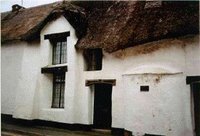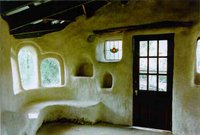
 From Wikipedia, the free encyclopedia
From Wikipedia, the free encyclopediaCob is a building material consisting of clay, sand, straw, water, and earth. Cob is fireproof, resistant to seismic activity, and inexpensive. It can be used to create artistic, sculptural forms and has been revived in recent years by the natural building and sustainability movements.
History and usage
Cob-building is a traditional technique that has been used for thousands of years and in all kind of climates. In the U.K. it is most strongly associated with counties of Devon and Cornwall, where many cob cottages have survived and are still lived in. Many old cob buildings can be found in Africa, the Middle East, Wales, and some parts of the eastern United States. The walls of a cob house are necessarily thick, and windows are correspondingly deepset, giving the houses a characteristic internal appearance. The thick walls also provide excellent thermal mass, so that, depending on the climate, cob cottages are relatively easy to keep warm in winter, and tend to be cool in summer. Surprisingly, the material is entirely suitable for rainy climates, and so long as a cob house is reasonably cared for, the structure will not deteriorate; many cob cottages in Devon (one of the wetter counties in England) have been inhabited for hundreds of years. Cob has many similarities to the adobe associated with Mexico and the southwestern United States, but whereas adobe is formed into bricks which are then stacked into a wall system, cob is sculpted from the foundation up.
Where sand is not readily available paper pulp may be added to the clay to minimize cracking when the COB dries.
 Modern cob buildings
Modern cob buildingsIn 2006, a modern, four-bedroom cob house in Worcestershire, UK, sold for £745 000. Cobtun House was built in 2001 and won the Royal Institute of British Architect's Sustainable Building of the Year award in 2005. The total construction cost was £300 000, but the metre-thick cob outer wall cost only £20 000.
No comments:
Post a Comment